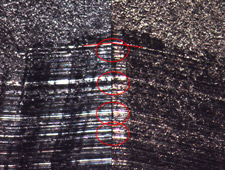Home | Glossary | Resources | Help | Contact Us | Course Map
Archival Notice
This is an archive page that is no longer being updated. It may contain outdated information and links may no longer function as originally intended.
Pattern Identification
Pattern matching is the process of determining whether or not the striated toolmarks on two objects, such as fired bullets, correspond. This is a somewhat subjective process based on the observations and experience of the examiner with the ultimate goal of making a pattern identification.
Pattern matching is the standard method for firearms identification. However, it can be difficult to articulate to a jury how an identification is determined using this process.
Some attempts have been made to define this process in quantitative terms as opposed to the traditional qualitative methods. An example of this is the consecutive matching striation approach.
Consecutive Matching Striae
An evolving concept in bullet comparison is the study of consecutive matching striae (CMS) as a quantitative method of describing an observed pattern match. Using CMS is a means of articulating the best known non-match described and defined by the AFTE Theory of Identification.
CMS was initially proposed in 1959 by Al Biasotti. In an analysis of 720 known nonmatch comparisons of land and groove impressions, he found no instances in which the CMS exceeded four. In 1997, Biasotti and John Murdock jointly published their paper titled Conservative Quantitative Criteria for Identification using the CMS criteria.
Their criteria for identification was defined as:
"In three dimensional toolmarks when at least two different groups of at least three consecutive matching striae appear in the same relative position, or one group of six consecutive matching striae are in agreement in an evidence toolmark compared to a test toolmark. In two dimensional toolmarks when at least two groups of at least five consecutive matching striae appear in the same relative position, or one group of eight consecutive matching striae are in agreement in an evidence toolmark. For these criteria to apply, however, the possibility of subclass characteristics must be ruled out."
A number of significant studies have been carried out in an effort to further validate these conservative criteria.
Although not necessarily practiced by all firearm examiners, these criteria are of increasing importance in consideration of
- the expectations of more sophisticated jurors,
- the need for more objective identification criteria,
- the changing environment of the courtroom following Daubert v. Merrell Dow Pharmaceuticals ,
- the potential for increased credibility for examiners in the courtroom.
Additional Online Courses
- What Every First Responding Officer Should Know About DNA Evidence
- Collecting DNA Evidence at Property Crime Scenes
- DNA – A Prosecutor’s Practice Notebook
- Crime Scene and DNA Basics
- Laboratory Safety Programs
- DNA Amplification
- Population Genetics and Statistics
- Non-STR DNA Markers: SNPs, Y-STRs, LCN and mtDNA
- Firearms Examiner Training
- Forensic DNA Education for Law Enforcement Decisionmakers
- What Every Investigator and Evidence Technician Should Know About DNA Evidence
- Principles of Forensic DNA for Officers of the Court
- Law 101: Legal Guide for the Forensic Expert
- Laboratory Orientation and Testing of Body Fluids and Tissues
- DNA Extraction and Quantitation
- STR Data Analysis and Interpretation
- Communication Skills, Report Writing, and Courtroom Testimony
- Español for Law Enforcement
- Amplified DNA Product Separation for Forensic Analysts


